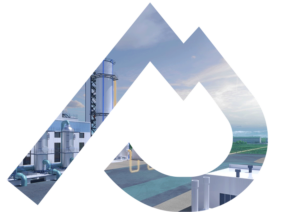
Pycasso Project CO2
capture and storage solutions
The capture and storage of residual carbon from industry are the first and last links in the CCUS chain. Within the Pycasso project, the capture step takes place on the most active sites in the Pyrenean foothills. Storage is carried out at a number of geological target sites, with depleted deposits in the territory as the top priority.
Application of CO2 capture: the first step
On the Lafarge Martres-Tolosane industrial cement works (the first partner site of the Pycasso project), the decarbonisation process upstream of capture is already fully applied. It is implemented throughout the production process through the use of more energy-efficient kilns, alternative fuels sourced from waste, and the use of less polluting raw materials. Nevertheless, the business continues to generate a significant volume of incompressible carbon dioxide, because of the obligation to use limestone (composed of 40% CO2) to produce cement.
The technique of capturing Co2 by cold distillation envisaged by Lafarge is already used by other industrial actors and delivers optimal performance, allowing the near-total elimination of the residual carbon. A platform will be operational in 2025, to initiate the pre-treatment of gases emitted by the cement works during test phases and be ready by 2031.
The site capture point will be connected to the main transport grid. Extraction will be subject to safety checks at the pipeline entry point, which will guarantee the purity of the CO2 being delivered.
Understanding CO2 capture
What is carbon capture?
This is the ultimate decarbonisation step in industry. It applies solely to the residual CO2 that remains, in spite of all the solutions available to avoid and reduce energy consumption, along with the use of renewable and low-carbon energy.
How does CO2 capture work?
CO2 capture consists in extracting the carbon from the combustion fumes released from chimneys and concentrating it, so as to make it pure and transportable to a storage site or useable as a raw material. This new raw material will be likely to be used by green chemicals companies to produce renewable fuels for aviation, for example.
Is CO2 capture efficient?
CO2 capture processes allow 90% efficiency to be achieved, and result in recovered CO2 with a purity close to 95%, or even higher. From an energy point of view, however, you have to consider the relatively energy-intensive nature of the process (energy expenditure of around 0.65 MWh per tonne of CO2 captured), which may draw on a source of electricity in the form of fatal heat or from biomass.
Why CO2 capture?
According to the IPCC’s latest report, world greenhouse gas emissions must fall in a fast and sustained manner from 2025. Without a sufficient reduction, it would be impossible to limit global warming to +2°C or even +1.5°C. The consequences would then be dramatic and irreversible. In its Net Zero by 2050 report, the International Energy Agency (IEA) sets out a practical roadmap to achieving carbon neutrality. Carbon capture at the industrial level is one part of the foundations on which any significant results will be built. In fact, uncaptured residual industrial CO2 is discharged into the atmosphere in exhaust fumes from factories, and makes up a significant proportion of the GHGs that impact climate change. It is therefore essential to use effective resources to capture it.
Is CO2 capture a convoluted way of making industry richer?
The subsidies from France and Europe finance the implementation of the CCUS chain, serving the objectives of combating climate change through the reduction of greenhouse gas emissions and the disappearance of fossil fuels. An indirect economic consequence is expected, which will benefit the conversion of industry and safeguard associated jobs.
CO2 storage implementation: sedimentary basins are the priority
The Far South-West of France has the largest potential for terrestrial carbon storage (750 Mt estimated to be available, according to the survey and prospects of CCUS deployment in France). In this respect, and according to current understanding, the Pycasso project favours storage in depleted hydrocarbon deposits, but also looks at other storage options such as salt aquifers. To be stored, captured CO2 would be injected underground, into the heart of natural geological formations, formerly exploited for the extraction of gas and oil. One alternative storage approach, in salt aquifers, will also be examined to offer an alternative and complementary solution.
Detailed State-run studies are continuing, to establish the actual CO2 storage capacities at the different French sites and to guarantee their conformity for containing CO2 in a sustainable way and under optimal safety conditions.
Understanding CO2 storage
This territory alone possesses 70% of land-based storage capacity in France. Initial studies have confirmed its capacity to sequester CO2 in a safe and sustainable way, because of its industrial past and its geological composition which once harboured the largest national natural gas resources.
CO2 buried in the depleted deposits is sequestered there in a sustainable and secure way, due to the natural geological composition of the reservoirs, which have historically stored gases which have now been used up. Continuous monitoring of those reservoirs will then be put in place to monitor any underground behaviour in real time, during the injection phases and well afterwards.
